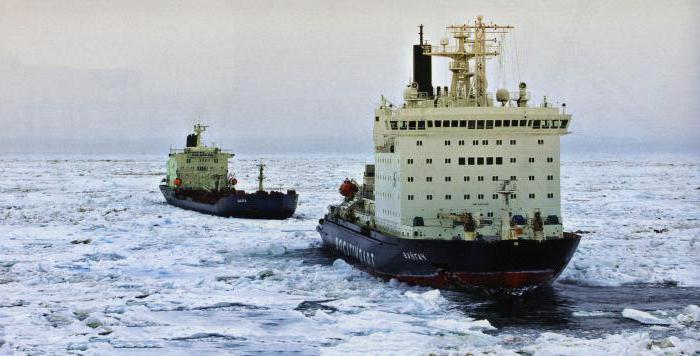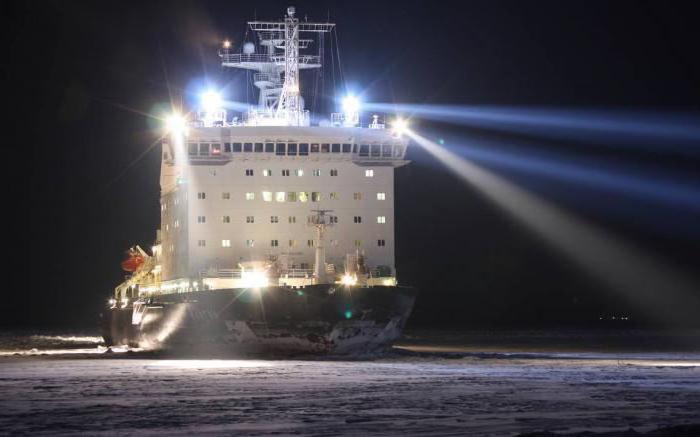A unique field of application for the peaceful atom is the icebreaker fleet. Its undeniable advantage is proved in the harsh polar conditions of the Russian Arctic. In recent years, the government has taken a course aimed at establishing tactical and strategic superiority in the waters of the North Ocean. Strengthening the position of the Northern Sea Route , bringing it to a competitive position with the Suez Canal is not only an opportunity, but also an obligation of our icebreakers. The development of offshore fields in the Arctic dictates new conditions for the development of the Russian icebreaking base. Four operating nuclear-powered icebreakers, one nuclear-powered container ship and two icebreakers of Project 2220 Arktika, already launched at the Baltic Shipbuilding Plant, are the only icebreaking fleet in the world that already envies our neighbors on the Arctic coast. And he puts the check and checkmate in the party for supremacy in the northern waters. The operating nuclear-powered icebreakers Vaigach and Taimyr are the main vessels in this flotilla.
Peaceful and military significance
In the Russian part of the Arctic, according to some estimates, about 40% of the world's oil and gas reserves are located. The offshore platform only in the Pechora Sea (Prirazlomnaya) is already ready today to bring oil production indicators to 400 thousand tons. The Northern Sea Route is 20 days shorter than Egyptian (17 days against 37) and this opens up Pacific energy markets for our energy carriers. In addition, modern intercontinental missiles fired from the neutral waters of the Arctic will reach our capital in fifteen minutes. Given these facts and the neighbors' claims to mineral deposits, Russia needed to be fully equipped to defend its interests in this zone. It is here that the Vaigach, Taimyr nuclear-powered icebreakers and the Sevmorput container ship will give our country the necessary advantages.
The history of nuclear icebreakers
The domestic icebreaker fleet starts from the first nuclear-powered icebreaker Lenin, which was put into operation on 12/03/1959. Since that time, the Northern Sea Route has acquired the significance of the national northern transport artery. Year-round navigation along this path was opened by the Arctic nuclear-powered icebreaker in 1975. The formation of the industrial complex in Norilsk, the year-round port of Dudinka justified the development of icebreaking shipping in Russia.
What we have today
Historically, Russia has always ordered many different icebreakers - steam and diesel. Today, 39 diesel vessels of various capacities operate in the Arctic zone. But the atomic monsters of the ice open spaces are expensive and there have never been many of them. The listing of the kings of the North will not take up much space.
- Nuclear-powered icebreaker Lenin is the first in the line of the Arctic project and the world's first surface ship with a nuclear installation. He is considered to be the father of all Russian icebreakers with nuclear reactors. He worked for 30 years (1959-1989), and today it is a museum of ice victories in Murmansk.
- The Taimyr project - two icebreakers with reduced draft, enabling navigation in the mouths of the northern rivers. The power of the icebreakers on the shafts is 35.5 MW, the displacement is 21 tons. Both - "Taimyr" and "Vaigach" - in the ranks.
- The icebreaking and transport vessel Sevmorput is the largest of the existing icebreakers by displacement (almost 62 thousand tons). It independently overcomes ice up to a meter thick. After a scheduled repair in 2016, it is back in operation.
- The largest Arctic project is six nuclear powered vessels with a capacity of 55 MW, which are capable of pushing ice three meters thick. Displacement is also not small - 23 tons. The legendary icebreaker "Arctic" (project 10520), which in 1977 was the first in the world to reach the North Pole, is a vivid representative of this project. Today, three ships of this series are in service - Yamal, 50th Anniversary of Victory, and Soviet Union. The latest project of the series - 2220 - is nuclear powered ships with a 60 MW installation that can push 3 meters of ice, work in the ocean and in shallow river mouths, and also transform into a fighting vehicle if necessary.
Tasks of the Russian icebreaking fleet
All our icebreakers are designed to provide the country's advantage in the Arctic waters when the ice season begins. But the scope of tasks for icebreakers is wider:
- Providing freight traffic along the Northern Sea Route. In recent years, it has grown almost three times in comparison with the flow of the 1990s. And continues to grow.
- Providing hydrocarbon projects in the Arctic.
- Study of the hydrometeorological regime of the water area.
- Study of the mineral resource potential of the Arctic shelf zone.
- Support for expeditions of the North Pole drifting polar station and remote island territories.
- Tourism development and attracting foreign investors to the development of the infrastructure of the North.
Taimyr Project
The Soviet project 10580 is two vessels - the lead ship of the same name and the Vaigach serial icebreaker - with hulls built at the Vyartsilya Marine Technique shipyard (Helsinki, Finland) in the eighties of the last century. Soviet steel was used, the KLT-40M reactor was also Soviet-made. The equipment was installed at the Baltic Shipbuilding Plant (Leningrad). Icebreakers of the series are ready to work at temperatures up to minus 50 degrees Celsius, have a reduced draft. This allows them to work at the mouths of the northern rivers. The reactor facility allows the Vaigach icebreaker to develop a maximum speed of 2 knots when passing through the ice 1.78 meters thick. A one-reactor plant has a capacity of 50 horsepower.
Specifications
The nuclear-powered icebreaker Vaigach, the project’s serial icebreaker, has slightly better performance than the parent icebreaker. The ship is named after the icebreaker of the same name of the twentieth century, crashed in the Yenisei Gulf (1918). The nuclear-powered icebreaker Vaigach (its home port is Murmansk) was commissioned in 1990 and immediately started work. The hull length is 151.8 meters with a width of 29.2 meters. Draft is low - 8.1 meters. The nuclear installation is a single-reactor KLT-40M with a capacity of 171 MW, the power plant - two turbogenerators. An icebreaker passes ice 1.77 meters thick and is capable of entering the mouths of rivers flowing into the Arctic Ocean. It has a displacement of about 21 tons of power on shafts of 35.5 MW, and three propellers provide an icebreaker with an open water speed of 18.5 knots. The autonomy of the Vaigach icebreaker is 7.5 months. The crew is 100 people.
A spoonful of tar turned out to be a spoonful of honey
The fire on board the icebreaker in December 2011, which claimed the lives of two people, was an indicator of the overall safety of the nuclear installation. The fire occurred in a residential compartment, the reasons were network overload and a fire of the computer system unit. The actions of the crew, the fire was quickly eliminated. The development of the emergency took place according to the worst scenario assumed in the technological design: with heavy smoke and rapid spread of fire throughout the ship. Based on the results of an interagency audit, it was concluded that the nuclear-powered team is ready for emergency situations and the safety of a nuclear reactor meets all international requirements. The actions of Captain First Rank Vasily Golokhvastov and other crew members were adequate and evaluated by the Russian government. For the courage shown in extinguishing the fire, the motor engineer of the nuclear department Pavel Bozhuyev in 2014 was posthumously awarded the Order of Courage. And the experience of eliminating this contingency was used in the development of technical conditions for new icebreaker projects.

Record passage along the Northern Sea Route
It was Vaigach in December 2015 that set the speed record for the latest passage from Cape Dezhnev along the Northern Sea Route to Bely Island. He covered 2250 miles in 185 hours. The average speed of the nuclear-powered ship was 12.5 knots. Nobody has beaten this record yet, and it’s still too early to write off the nuclear atomic icebreaker Vaigach, which is still Soviet.
Resource extended
Completed in April 2017 under the guidance of a reactor designer at JSC Design Bureau named after I.I. Afrikantov ”(Nizhny Novgorod), work to extend the life of the reactor of the atomic icebreaker Vaigach ended successfully. For the first time, the life of a reactor installation was extended from 175 thousand to 200 thousand hours. Now the icebreaker will last until 2022. The last scheduled repair in the port of Murmansk “Vaigach” is again in the ranks of monsters of ice expanses. The atomic icebreaker Taimyr, the lead ship of the project, expects the same procedure. By the end of this year, the Atomflot Federal State Unitary Enterprise expects to completely eliminate the so-called “ice break” in northern navigation and to launch year-round pilotage of ships using the Arctic 2220 icebreakers under construction, the first of which (the Arctic nuclear icebreaker) stands in the port of the city of Murmansk.
Unique "Northern Sea Route"
It is worth saying a few words about this unique ship of ice open spaces, inherited from the Union of Soviet Socialist Republics and having a difficult fate, but happily ending. It was laid in 1984, came off the stocks of the Zeriv factory in Kerch in 1988. The monster was astonishingly the size of a five-story building (height -18 meters), with an open water speed of 20 knots and the ability to break ice up to a meter thick with a displacement of 62 tons, during the first years of its life it carried out friendly flights to Vietnam, Korea, the People’s Republic of China and Saudi Arabia And only in 1993 the ship saw the northern ice, when it began to work on the route Murmansk - the port of Dudinka of the Northern Sea Route. From 2007 to 2012, the vessel was idle due to a lack of funds for the purchase of fuel, and a decision was made to shut down the nuclear reactor and remove it from the register of ships. The ship was awaiting disposal and scrap metal. But in 2013, the icebreaking transport vessel Sevmorput was decided to be restored, and in 2015 the lighter carrier returned to the waters of the Arctic. So the ship came back to life, capable of taking on board 47 three-hundred-ton flat-bottomed container bases (lighters).

And finally
In anticipation of the ultra-modern nuclear icebreakers of the Arctic Project 2220 and the LK-110Ya Leader project, the single-reactor low-draft workers Taimyr and Vaigach continue to conquer the ice hummocks of the Arctic. Rescue from ice captivity in the winter months of 2011, about 250 ships from the Gulf of Finland - though significant, but not the only high-profile victory of the Vaigach nuclear-powered ship. And while ultramodern monsters of ice waters are being finalized, their smaller but hardworking brothers continue to watch on the waters of the Arctic Ocean, ensuring the smooth development of the harsh and promising Arctic.